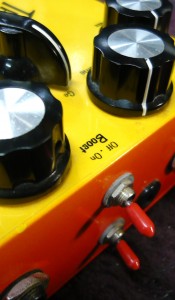Tym Tripletone distortion
Share
So here's another gem from back in the "good ol' days" of Tym guitars. This one came back for a repair from the original owner but no fault was found ? I hadnt played one for years and it reminded me what a great pedal this is and it deserves a blog story of its own.
This was made before my Dog Head series and spun off from my original series that were painted Hammond enclosures with clear bubble jet stickers on top and coated with clear lacquer.
The prototypes would have been made in the late 90's with these "production" versions being available from around 2000/2001.
I got the original idea from making MXR Distortion + style circuits with germanium and/or silicon clipping. The Dist + circuit is still one of my favorites and while i still like the current re-issue a lot, its not quite as good as the older units. I actually also love the DOD 250 as well which is essentially the same circuit as well. One of the few pedals I've ever regretted selling was an original 250. After messing with this circuit a bit I eventually thought I'd try making one that could switch between the different clipping stages.
One of the other things I always wanted a Dist + to do was go to 11. While I love the clarity and tone of the MXR I always run the gain on full and I always had that nagging feeling of "what would it be like if it just went that little bit further ?"


So the Tripletone is based on the Dist + circuit but with more gain, LOTS more gain. It's actually more like a Dist + that goes to 20. We had trouble with oscillation at these high gain settings and had to physically space the layout bigger to fix this problem. Even with all this gain, me being me, I added a boost circuit as well which at the time I described as "infinite gain" when running the circuit and boost on full. It is A LOT of gain but still holds some clarity thanks to rolling off some bottom end as the gain increases.
Once this gain circuit was finished we added the switch to choose diodes. Since I was using germanium and silicon already we thought we'd add LED as well, hence the name.
The prototypes were very promising and I loved the amount of gain and the variety from the different clipping. I was making another pedal at the time I called a "Filter" that was essentially an active 2 band (treble and bass) eq that had cut and boost with good sweep. I decided I would incorporate this filter pedal into the gain circuit which made the Tripletone an incredably versatile pedal.
After a few prototypes on veroboard we drew out a PCB and got some printed at a local engineering shop. I was doing all my own vero and acid etch PCB's at this stage but this circuit was way too complex to produce in any real numbers using these methods so this pedal was my first real foray into actual PCB's.
The paint was influenced by my sunbursting I was doing on guitars at the time and I figured I could quickly paint these three colour sunbursts without much trouble and then attach the clear label to the top and then just a couple of quick coats of clear. This, with the standard Hammond enclosures and PCB's were all aimed at being my first "real" production effects pedal. Unfortunately there was A LOT of hand wiring after the PCB's and enclosures were ready to load. There was something like sixty pieces of short wire that connected all the pots, jacks, switches etc to the PCB. That's cutting sixty pieces of wire to certain lengths and stripping both ends and tinning them before starting to assemble. It was a lot of work by hand.
The pedal has a mini toggle switch for the boost and a mini toggle for battery on/off. This second switch was influenced by one of the othe pedals I was making at the time, the Buzzrite. I did like the idea of a battery switch as you can leave your pedal attached to your board and plugged in and not flatten your battery.
There was also a version of this pedal made that was called the "K series" which was specifically made for bass and had a built in DI output (pre distortion) It was designed for and named the "K" after Kellie from Screamfeeder who used this pedal for years. I'll do a story on one of these soon as I still have one prototype/production version around here somewhere ?
These sold reasonably well and I had waiting lists (yeah, that's right, even back then) for them but even with friends helping I couldn't build these fast enough and cost effectively. It was a real shame as after playing this one again (after over ten years of not hearing one) I really think this is a pretty damn cool pedal and might well and truly be worth re-issuing in an "easier to build" version ?








